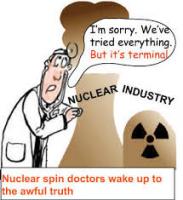The rapidly-evolving nuclear power crisis escalated dramatically yesterday
(March 29) with the announcement that US nuclear giant Westinghouse, a
subsidiary of Japanese conglomerate Toshiba, has filed for bankruptcy. The
Chapter 11 filing took place in the US Bankruptcy Court for the Southern
District of New York in New York City.
Toshiba and Westinghouse are in crisis because of massive cost overruns building
four 'AP1000' nuclear power reactors in the southern US states of Georgia and
South Carolina. The combined cost overruns for the four reactors amount to
about US$11.2 billion and counting.
Whether the four reactors will be completed is now subject to an "assessment
period" according to Westinghouse.
No other reactors are under construction in the US and there is no likelihood
of any new reactors in the foreseeable future. The US reactor fleet is one of
the oldest in the world ‒ 44 out of 99 reactors have been operating for 40
years or more ‒ so nuclear decline is certain.
Toshiba
says Westinghouse had debts totalling US$9.8 billion. Plans for new
Westinghouse reactors in India, the UK and China are in jeopardy and will
likely be cancelled. Bloomberg
noted yesterday: "Westinghouse Electric Co., once synonymous with
America’s industrial might, wagered its future on nuclear power ‒ and
lost."
The same could be said about Toshiba, which is selling profitable businesses to
stave off bankruptcy. Toshiba said yesterday it expects to book a net loss of
US$9.1 billion for the current fiscal year, which ends on Friday ‒ a record
loss for a Japanese manufacturer. That projected loss is well over double the
estimate provided just last month. “Every time they put out an estimate, the
loss gets bigger and bigger,” said Zuhair Khan, an
analyst at Jefferies in Tokyo. “I don’t think this is the last cockroach we
have seen coming out of Toshiba.”
The BBC noted that Toshiba's
share-price has been in freefall, losing more than 60% since the company first
unveiled the problems in December 2016. Toshiba president Satoshi
Tsunakawa said
at a news conference yesterday: “We have
all but completely pulled out of the nuclear business overseas.”
A similar crisis is unfolding in France, which has 58 power reactors but just
one under construction. French 'EPR' reactors under construction in France
(Flamanville) and Finland are three times over budget ‒ the combined cost
overruns for the two reactors amount to about €12.7 billionand counting. The
French government is selling assets so it can prop up its heavily indebted
nuclear utilities Areva and EDF. The French nuclear industry is in its
"worst situation ever" according to former EDF director Gérard
Magnin.
Dr Jim Green, national nuclear campaigner with Friends of the Earth Australia,
said: "Nuclear lobbyists are abandoning the tiresome rhetoric about a
nuclear power renaissance. They are now acknowledging that the industry is in
crisis. The crisis-ridden US, French and Japanese nuclear
industries account for half of worldwide nuclear power generation. Countries
with crisis-ridden nuclear programs or nuclear phase-out policies account for
more than half of worldwide nuclear power generation. Nuclear industries in
some other countries ‒such as the UK ‒ are in deep trouble and are approaching
a crisis situation."
"Renewable energy generation doubled over the past decade and strong growth,
driven by sharp cost decreases, will continue for the foreseeable future.
Conversely, the Hinkley Point project in the UK typifies nuclear power's
staggering cost increases ‒ the estimated construction cost is A$40 billion for
two reactors," Dr Green said.
Contact: Dr Jim Green 0417 318 368

